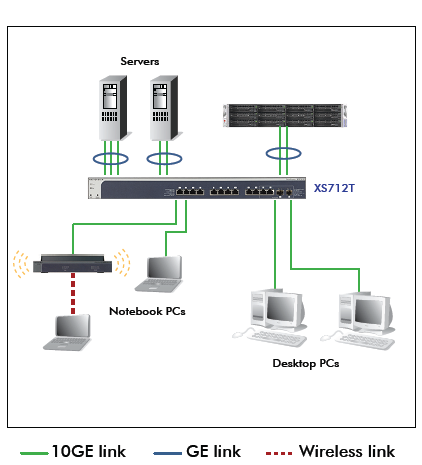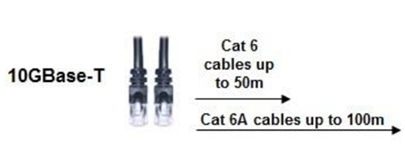With the growth of virtualization, cloud-based services and applications like VoIP, video streaming and IP surveillance, SMB networks need to extend beyond simple reliability to higher speed and performance. As a leading provider of networking equipment for SMBs, Netgear had launched a variety of cost-effective 10GBASE-T switches including Netgear ProSAFE XS708Ev2, XS716E, XS708T, XS712T, XS716T, XS728T, XS748T and XSM7224. When looking for a lower cost and high capacity 10GBASE-T switch in SMB home/office lab environments, the Netgear ProSAFE XS712T is one of the best options. It comes in at around $1,100 at Amazon which is more budget friendly than the larger data center switches. This article will review the Netgear ProSAFE XS712T (XS712T-100NES) 10GBASE-T switch.
Netgear ProSAFE XS712T is a powerful smart managed switch that comes with 10 dedicated 10GBASE-T RJ-45 copper ports supporting 100M/1G/10G speeds and 2 combo copper/SFP+ fiber 10G ports. The 2 combo SFP+ ports can be used as 10GASE-T ports or as SFP+ 10Gb Ethernet ports. This is an awesome feature as it allows an inexpensive SPF+ link via DAC to a 24 or 48 port 1Gb Ethernet switch for non-10Gb networking needs. All ports can automatically negotiate to the highest speed, which makes the switch ideal for environments that have a mix of Ethernet, Fast Ethernet, Gigabit Ethernet, or 10-Gigabit Ethernet devices. Cat 5e/Cat 6/Cat 6a/Cat 7 can be used to make 10G connections. Cat 6a/Cat 7 cables are recommended if the cable distance is greater than 45 meters. Besides, the smart switch can be freestanding or rack mounted in a wiring closet or equipment room. This 10G smart managed switch is purposely designed as a cost-effective way to provide 10G connections to 10G-capable servers and NAS (Network Attached Storage) systems. It also can be used at the center of a small business network or as an aggregation/access switch in a larger organization.

Figure 1: Netgear ProSAFE XS712T (Source: www.netgear.com )
In order to meet the current and future needs on virtualization, converged network and mobility, the XS712T provides comprehensive L2+/Layer 3 Lite features, such as VLAN, QoS, IGMP and MLD snooping, Static Routing, Link Aggregation, ACL binding. Besides, it has an easy-to-use Web-based management GUI which makes setup and management simple. Some of main features include:
The RJ-45 copper ports of XS712T comply with IEEE 10GBASE-T standards. They support low-latency, line-rate 10G copper “Base-T” technology with backward compatibility to Fast Ethernet and Gigabit Ethernet. So it allows for a cost effective and simpler upgrade path to 10-Gigabit Ethernet. The existing Cat5/Cat5e is supported for Gigabit speeds up to 100 meters, Cat6 for 10-Gigabit speeds up to 45 meters and Cat6a/Cat7 for 10GBASE-T connection up to 100 meter.
The powerful L2+/Layer 3 Lite features make XS712T the most cost-effective core switches for SMB and virtualization environment. This switch is also a future-proofing choice with 10G bandwidth, advanced traffic management and comprehensive IPv6 support.

Figure 2: Netgear ProSAFE XS712T in SMB Network (Source: www.netgear.com )
The XS712T used as a aggregation switch has many useful purposes. It can help to resolve the congestion issue between network edge and core, which is caused by the broader adoption of Gigabit-to-the-desktop. Unlike multiple Gigabit Ethernet links, it provides greater scalability resulting in a simplified and highly efficient network infrastructure. What’s more, it can reduce cabling complexity because it can use existing cabling efficiently.
As mentioned above, The Netgear ProSAFE XS712T smart switch provides 12 twisted-pair ports that support nonstop 100M/1000M/10G networks. The switch also has two built-in SFP+ GBIC combo slots that support 1000M and 10G optical modules. Using these Gigabit slots, 100M/1000M/10G copper and 1000M/10G fiber connectivity can create high-speed connections to a server or network backbone. So 1000BASE-T SFP copper transceiver, 1000BASE SFP and 10G SFP+ transceivers are suitable for this switch. The following table lists the compatible transceivers and optic cables from FS.COM.
| MFG PART# | Description |
| AGM734 | NETGEAR AGM734 Compatible 1000BASE-T SFP Copper 100m Transceiver, RJ-45 Interface |
| AGM731F | NETGEAR Compatible 1000BASE-SX SFP 850nm 550m DOM Transceiver, LC Interface |
| AGM732F | NETGEAR Compatible 1000BASE-LX SFP 1310nm 10km DOM Transceiver, LC Interface |
| AXM761 | NETGEAR Compatible 10GBASE-SR SFP+ 850nm 300m DOM Transceiver, LC Interface |
| AXM762 | NETGEAR Compatible 10GBASE-LR SFP+ 1310nm 10km DOM Transceiver, LC Interface |
| AXM763 | NETGEAR Compatible 10GBASE-LRM SFP+ 1310nm 220m DOM Transceiver, LC Interface |
| AXM764 | NETGEAR Compatible 10GBASE-LR Lite SFP+ 1310nm 2km DOM Transceiver, LC Interface |
| AXC761 | 1m NETGEAR Compatible 10G SFP+ Passive DAC |
| AXC763 | 3m NETGEAR Compatible 10G SFP+ Passive DAC |
The Netgear XS712T (XS712T-100NES) provides a solid cost-effective solution especially for those with SMB home/ office lab environments. If you are seeking for afforable 10GBASE-T switch for your home lab, the XS712T can be taken into consideration. What’s more, the compatible fiber transceivers and cables can be found in many third party vendors with reasonable prices, such as cablestogo, fluxlight, smartoptics, FS.COM, and etc. You have a lot of choices to save money.



 Listed below are several reasons why 10GBASE-T become the 10GbE media option.
Listed below are several reasons why 10GBASE-T become the 10GbE media option.
